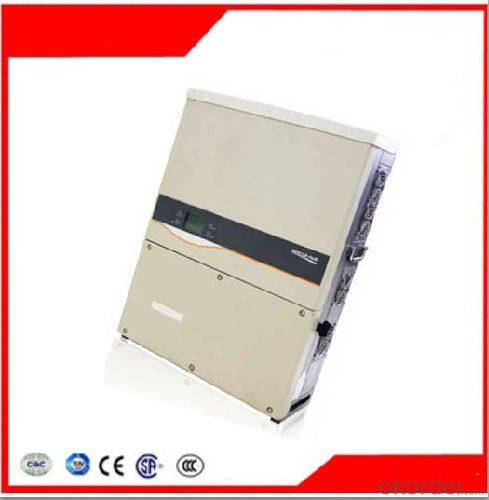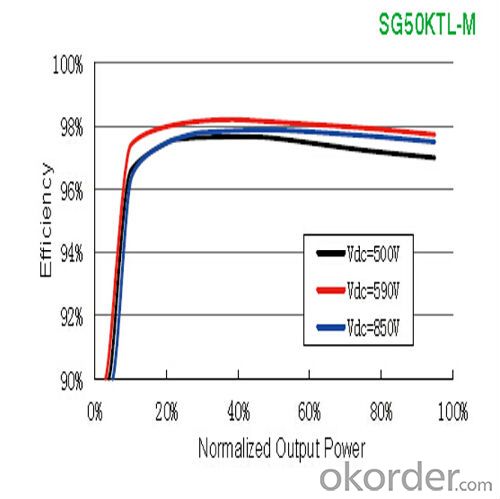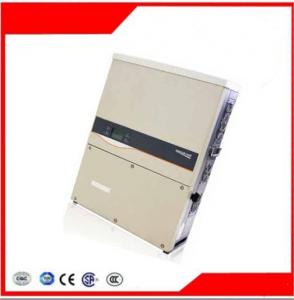Photovoltaic Grid-Connected Inverter SG50KTL-M
- Loading Port:
- China Main Port
- Payment Terms:
- TT or LC
- Min Order Qty:
- 500000 unit
- Supply Capability:
- 3000000 unit/month
OKorder Service Pledge
OKorder Financial Service
You Might Also Like
1. Structure of Photovoltaic Grid-Connected Inverter SG50KTL-M Description
A solar inverter, or PV inverter, or Solar converter, converts the variable direct current (DC) output of a photovoltaic (PV) solar panel into
autility frequency alternating current (AC) that can be fed into a commercial electrical grid or used by a local, off-grid electrical network.
It is acritical BOS–component in a photovoltaic system, allowing the use of ordinary AC-powered equipment. Solar inverters have
special functions adapted for use with photovoltaic arrays, including maximum power point tracking and anti-islanding protection.
Suitable for 50Hz/60Hz grid, could be used in Asia, Africa and Europe. Available for hand installation, no need for lifting machinery
assistance.
2. Main Features of the Photovoltaic Grid-Connected Inverter SG50KTL-M
• High flexibility for complex configurations due to 4 MPP trackers and a wide input voltage range
• High yields due to efficiency up to 98.9% and EU efficiency of 98.5%
• Output power up to 55kVA / 55kW(SG50KTL-M) and 66kVA / 66kW(SG60KTL-M) at power factor of 1
• Integrated combiner box: 12 x MC4 connector pairs with DC string fuses, Type II overvoltage protection and DC switch, more safety and lower the system cost
• Active power continuously adjustable (0~100%)
• Fulfill a variety of reactive power adjustment requirments with power factor 0.8overexited ~0.8 underexited
• Integrated LVRT and HVRT function
• Includes RS-485 interface, compatible with all common monitoring systems
• Product certification: TÜV, CE, G59/3, BDEW, CGC and GB-T19964
• Manufacturer certification: ISO 9001, ISO 14001, OHSAS 18000
3. Photovoltaic Grid-Connected Inverter SG40KTL Images



4. Photovoltaic Grid-Connected Inverter SG50KTL-M Specification
Side Data | |
Max. PV input power | 56200W |
Max. PV input voltage | 1000V |
Startup voltage | 300V |
Nominal input voltage | 590V |
MPP voltage range | 300~950V |
MPP voltage range for nominal power | 500~850V |
No. of MPPTs | 4 |
Max. number of PV strings per MPPT | 3 |
Max. PV input current | 104A(26A/26A/26A/26A) |
Max. current for input connector | 12A |
Output Side Data | |
Nominal AC output power | 50000W |
Max AC output power(PF=1) | 55000W |
Max. AC output apparent power | 55000VA |
Max. AC output current | 80A |
Nominal AC voltage | 3/N/PE, 230/400Vac |
AC voltage range | 310~480Vac |
Nominal grid frequency | 50Hz/60Hz |
Grid frequency range | 45~55Hz /55~ 65Hz |
THD | < 3 % (Nominal power) |
DC current injection | <0.5 %In |
Power factor | >0.99@default value at nominal power |
(adj. 0.8overexcited ~0.8underexited) | |
Protection | |
Anti-islanding protection | Yes |
LVRT | Yes |
DC reverse connection protection | Yes |
AC short circuit protection | Yes |
Leakage current protection | Yes |
DC switch | Yes |
DC fuse | Yes |
Overvoltage protection | DC Type II DIN rail surge arrester(40kA) |
System Data | |
Max. efficiency | 98.90% |
Max. European efficiency | 98.50% |
Isolation method | Transformerless |
Ingress protection rating | IP65 |
Night power consumption | <1W |
Operating ambient temperature range | -25~60℃(>50℃ derating) |
Allowable relative humidity range | 0~100% |
Cooling method | Smart forced air cooling |
Max. operating altitude | 4000m (>3000m derating) |
Display | Graphic LCD |
Communication | RS485 |
DC connection type | MC4 |
AC connection type | Screw Clamp terminal |
Certification | VDE0126-1-1,EN62109-1,EN62109-2,G59/3, |
BDEW,GB/T 19964, GB/T 29319 | |
Mechanical Data | |
Dimensions(W×H×D) | 665 * 906 * 256 mm |
Mounting method | Wall bracket |
Weight | 70kg |
5. FAQ of Photovoltaic Grid-Connected Inverter SG50KTL-M
Q1. What is the difference between inverter and solar inverter?
A1. Inverter only has AC inpput, but solar inverter both connect to AC input and solar panel, it saves more power.
Q2. What is the difference between MPPT&PWM?
A2. MPPT has higher efficiency, it can track the max power point and won't waste energy.
- Q:How does a solar inverter protect against short circuits?
- A solar inverter protects against short circuits by continuously monitoring the electrical current flowing through the system. It has built-in protective measures such as fuses, circuit breakers, or electronic switches that automatically disconnect the power supply in case of a short circuit. This prevents excessive current from damaging the solar panels, the inverter, or any connected electrical equipment.
- Q:What is the role of a solar inverter in anti-islanding protection?
- The role of a solar inverter in anti-islanding protection is to detect and prevent the occurrence of islanding. Islanding is a situation where a solar PV system continues to generate power and feed it into the grid during a power outage, which can pose a safety risk to utility workers attempting to restore power. The solar inverter monitors the grid voltage and frequency and when it detects an abnormality, such as a loss of grid connection, it quickly disconnects the PV system from the grid. This anti-islanding protection feature ensures that the solar system does not operate independently and helps maintain the safety and stability of the electrical grid.
- Q:Can a solar inverter be used in a ground-mounted solar system?
- Yes, a solar inverter can be used in a ground-mounted solar system. The solar inverter is an essential component that converts the direct current (DC) generated by the solar panels into alternating current (AC) that can be used to power electrical appliances or be fed back into the grid. Whether the solar system is mounted on the ground or on a roof, the inverter's role remains the same, making it compatible with ground-mounted systems.
- Q:How the output voltage of the PV inverter and the grid-connected voltage are determined
- DC voltage and AC side voltage does not matter, the general PV inverter AC output is 400V / N / PE. With no isolation transformer and output voltage does not matter, grid-connected inverter is the regulation of current, and network voltage depends on the grid voltage. And the grid before the inverter will detect the grid voltage, meet the conditions will be network.
- Q:How does a solar inverter handle fluctuations in solar panel output due to temperature changes?
- A solar inverter handles fluctuations in solar panel output due to temperature changes by employing a maximum power point tracking (MPPT) algorithm. This algorithm continuously adjusts the operating voltage and current of the inverter to ensure that it operates at the maximum power point of the solar panels, despite the temperature changes. By dynamically adapting to the varying output of the panels, the inverter optimizes the energy conversion process and allows for efficient utilization of the available solar energy.
- Q:How does a solar inverter handle voltage dip and interruption?
- A solar inverter handles voltage dip and interruption by continuously monitoring the electricity supply from the solar panels. In the event of a voltage dip or interruption, the inverter immediately adjusts its output voltage to match the required level, thereby stabilizing the power supply to connected devices. Additionally, some advanced solar inverters are equipped with built-in energy storage systems, such as batteries, which seamlessly take over during voltage dips or interruptions, ensuring uninterrupted power supply.
- Q:How does a solar inverter protect against overvoltage and overcurrent?
- A solar inverter protects against overvoltage by continuously monitoring the voltage levels of the solar panels and adjusting the conversion process to ensure that the output voltage remains within a safe range. In case of overvoltage, the inverter automatically reduces the power output or shuts down to prevent damage to the system. Similarly, the inverter safeguards against overcurrent by constantly monitoring the current flowing through the system. If the current exceeds the safe limits, the inverter utilizes protective measures such as reducing the power output, regulating the current, or triggering a shutdown to prevent any potential damage to the solar panels or connected devices.
- Q:How does a solar inverter handle electromagnetic interference (EMI)?
- A solar inverter typically handles electromagnetic interference (EMI) by incorporating various measures and technologies to minimize its impact. This includes using shielding materials and techniques to prevent EMI from affecting the internal electronics of the inverter. Additionally, filters and surge suppressors are employed to reduce EMI generated by the inverter from interfering with other electronic devices. Overall, the solar inverter aims to mitigate EMI issues to ensure optimal performance and minimize disruptions.
- Q:How does a solar inverter handle voltage and frequency variations caused by load shedding?
- A solar inverter handles voltage and frequency variations caused by load shedding by constantly monitoring the grid conditions. When it detects a drop in voltage or frequency, it adjusts its output parameters accordingly to maintain a stable supply of electricity to the connected loads. This ensures that the devices receiving power from the solar inverter are not affected by the fluctuations in the grid caused by load shedding.
- Q:What is the impact of temperature on the performance of a solar inverter?
- The impact of temperature on the performance of a solar inverter is significant. As temperature increases, the efficiency of the inverter tends to decrease. This is because higher temperatures can lead to increased resistive losses, increased internal losses, and decreased power conversion efficiency. Additionally, overheating can cause the inverter to shut down or operate at reduced capacity to prevent damage. Therefore, it is important to consider temperature management and cooling strategies to optimize the performance and lifespan of a solar inverter.
1. Manufacturer Overview |
|
|---|---|
| Location | |
| Year Established | |
| Annual Output Value | |
| Main Markets | |
| Company Certifications | |
2. Manufacturer Certificates |
|
|---|---|
| a) Certification Name | |
| Range | |
| Reference | |
| Validity Period | |
3. Manufacturer Capability |
|
|---|---|
| a)Trade Capacity | |
| Nearest Port | |
| Export Percentage | |
| No.of Employees in Trade Department | |
| Language Spoken: | |
| b)Factory Information | |
| Factory Size: | |
| No. of Production Lines | |
| Contract Manufacturing | |
| Product Price Range | |
Send your message to us
Photovoltaic Grid-Connected Inverter SG50KTL-M
- Loading Port:
- China Main Port
- Payment Terms:
- TT or LC
- Min Order Qty:
- 500000 unit
- Supply Capability:
- 3000000 unit/month
OKorder Service Pledge
OKorder Financial Service
Similar products
New products
Hot products
Related keywords
































